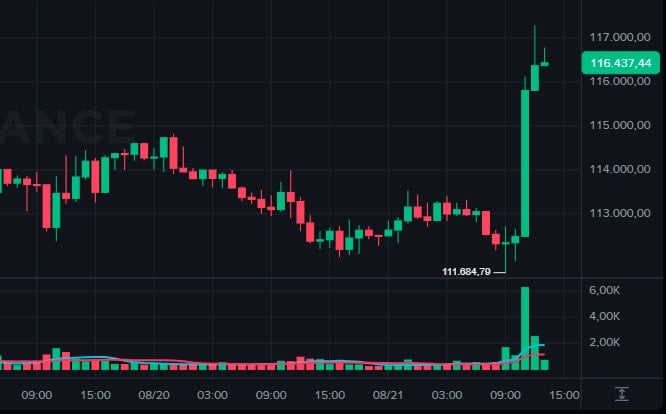Bitcoin Soars to $117 on Expectations of Interest Rate Cut
- Bitcoin rises on bets on lower interest rates
- Powell strikes cautious tone in Jackson Hole
- Cryptocurrencies react to Federal Reserve policy
Jerome Powell's speech at the Jackson Hole symposium brought relief to the markets, pushing Bitcoin's price to around $117.200, up 4% in the last 24 hours. Analysts interpreted the Federal Reserve chairman's more cautious tone as a sign of a possible interest rate cut at the meeting scheduled for September.

BTC's appreciation comes after days of negative pressure. Before the speech, the digital asset had fallen below $112, reflecting investors' defensive stance in the face of uncertainty. Ethereum, meanwhile, fell more than 4% in the same period but also rose again with the calmer market climate.
The speech's content was received as an "implicitly dovish" move, reinforcing the idea that the Federal Reserve is more willing to consider economic data before making new decisions, without adopting an aggressive monetary tightening stance. Powell emphasized the importance of flexibility in monetary policy, which was enough to restore some confidence among traders and analysts.
This type of signaling tends to increase market liquidity and increase risk appetite, which favors capital flows into the cryptocurrency sector. DeFi platforms, stablecoins, and asset tokenization projects tend to benefit from a macroeconomic environment with lower interest rates.
Still, experts warn that Powell maintained a data-driven approach, without making a direct commitment to rate cuts. This means that further movements in digital asset prices are likely to remain tied to economic updates and the Federal Reserve's own communications in the coming days.
Disclaimer: The content of this article solely reflects the author's opinion and does not represent the platform in any capacity. This article is not intended to serve as a reference for making investment decisions.
You may also like
When the Federal Reserve "cuts interest rates alone" while other central banks even start raising rates, the depreciation of the US dollar will become the focus in 2026.
The Federal Reserve has cut interest rates by 25 basis points as expected. The market generally anticipates that the Fed will maintain an accommodative policy next year. Meanwhile, central banks in Europe, Canada, Japan, Australia, and New Zealand mostly continue to maintain a tightening stance.

From MEV-Boost to BuilderNet: Can True MEV Fair Distribution Be Achieved?
In MEV-Boost auctions, the key to winning the competition lies not in having the most powerful algorithms, but in controlling the most valuable order flow. BuilderNet enables different participants to share order flow, reshaping the MEV ecosystem.

JPMorgan Chase issues Galaxy short-term bonds on Solana network
The three giants collectively bet on Abu Dhabi, making it the "crypto capital"
As stablecoin giants and the world's largest exchange simultaneously secure ADGM licenses, Abu Dhabi is rapidly emerging from a Middle Eastern financial hub into a new global center for institutional-grade crypto settlement and regulation.

